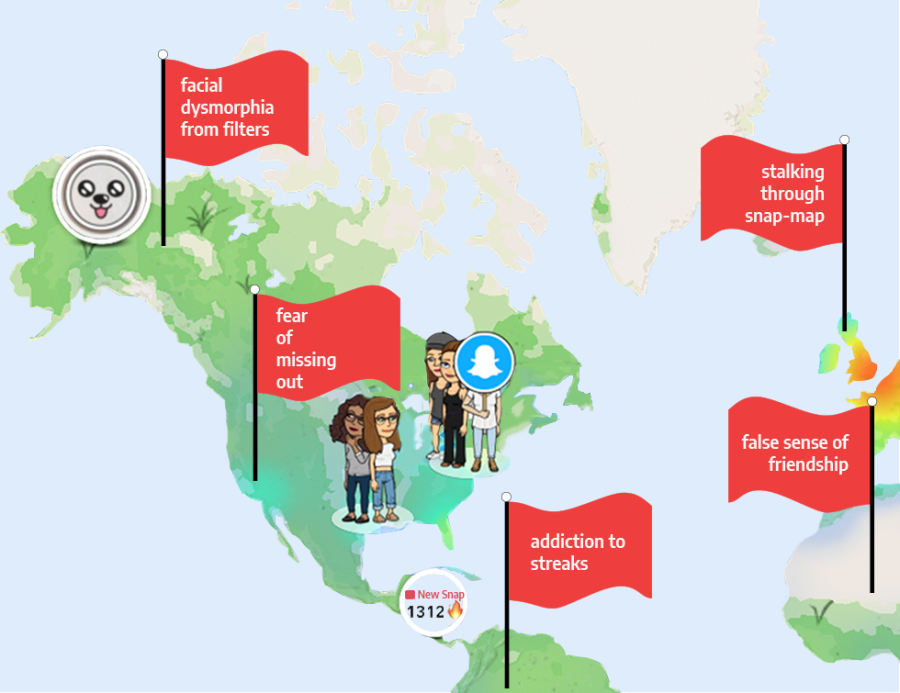Snapchat: Fostering friendships or competition?
Graphic illustration by Myles Kim
Snapchat’s optimistic mission is masked by users’ compulsive desires to maintain streaks and to illustrate a perfect life.
May 3, 2022
Approximately 319 million users every day tap on the iconic white ghost centered within a yellow box to reply to a friend’s “snap” — a picture or short video. Snapchat’s mission is to “empower people to express themselves, live in the moment, learn about the world and have fun together.” However, with the addition of streak counts displayed adjacent to each friend’s name and Snap Map, an interactive map that allows users to share their locations with friends, Snapchat’s optimistic mission is masked by users’ compulsive desires to maintain streaks and to illustrate a perfect life.
After two consecutive days of back-and-forth snaps between two users, a number indicating a streak count appears next to each user’s name. The addictive nature of Snapchat’s streaks comes from human beings’ natural desires to achieve dopamine rewards by continuing markers. The higher the number is, the more disappointment a broken streak would cause, often putting pressure on both sides of a friendship to add on to the streak to avoid taking the blame of the loss.
“When my parents took my phone, I deleted all of my apps, so I lost my highest streak of around 1,000,” freshman Rayyan Ghafoor said. “I felt horrible because I had just lost all of my hard work.”
Snapchat allows users to indirectly communicate with each other through short, disappearing snaps, creating a welcoming environment for those who feel anxious communicating with peers in person. Many even use Snapchat’s short-lived features as an excuse to start small conversations with someone.
Oftentimes, however, communication through snaps consists of meaningless to no conversations; many chats are chains of idle photos of ceilings, the ground or half of a face. To many teens, the continuous sending of snaps between two friends proves commitment to a friendship. Likewise, leaving a friend on “opened” or “delivered” can show disinterest. This type of communication can lead to a false sense of friendship that merely revolves around the momentary attention of another.
“Many people just mindlessly send streaks on Snapchat,” Ghafoor said. “You could be doing much more productive things in your life than sending streaks.”
Another one of Snapchat’s most enjoyed features is its filters. Although they are used for humorous intentions, some of the most popular Snapchat filters distort one’s face by altering the facial features or skin tones, which may suggest unrealistic beauty ideals, ultimately cultivating or acting as a temporary cure to facial dysmorphia, only to accentuate the condition when the filters are gone. Seeing a digitally modified version of oneself every day can be detrimental to mental health and can deter one from being content with their real appearances.
“Beauty filters make us compare ourselves to something that is not real,” school-based therapist Jenna Starnes said. “And our minds are bad at determining what’s real and not. As you’re seeing someone’s picture, you see someone who looks beautiful and you think to yourself, ‘I don’t look like that.’ But we don’t think, ‘this person doesn’t actually look like that’ either.”
Snap Map allows users to see their friends’ locations and the time they were last active. The Bitmojis, or personalized avatars, of friends who have enabled the sharing of their location appear on their current location on the map. Many parents and teens have expressed concerns about Snap Map’s invasion of privacy, as it allows users to see the whereabouts of their friends down to the street name and exact layout of the building, encouraging predators to stalk their victims.
“Snap Map also feeds into feelings of missing out,” Starnes said. “The worst case scenario is that you find your group of friends together without you. This could lead to the thoughts, ‘Am I missing out? Am I being excluded?’”
Many teens acknowledge the harm that Snapchat’s competitive culture can cause, yet they cannot seem to terminate the addiction. A few steps one can take toward overcoming the addiction is to turn off all notifications and to remove the app from one’s homescreen. Although the best thing to do is delete the app, the toughest step is getting past the initial withdrawal, so Starnes suggests users to distract themselves and to pay attention to the positive things that they are experiencing away from Snapchat.






























































jeffery • Sep 10, 2024 at 7:09 pm
i agree